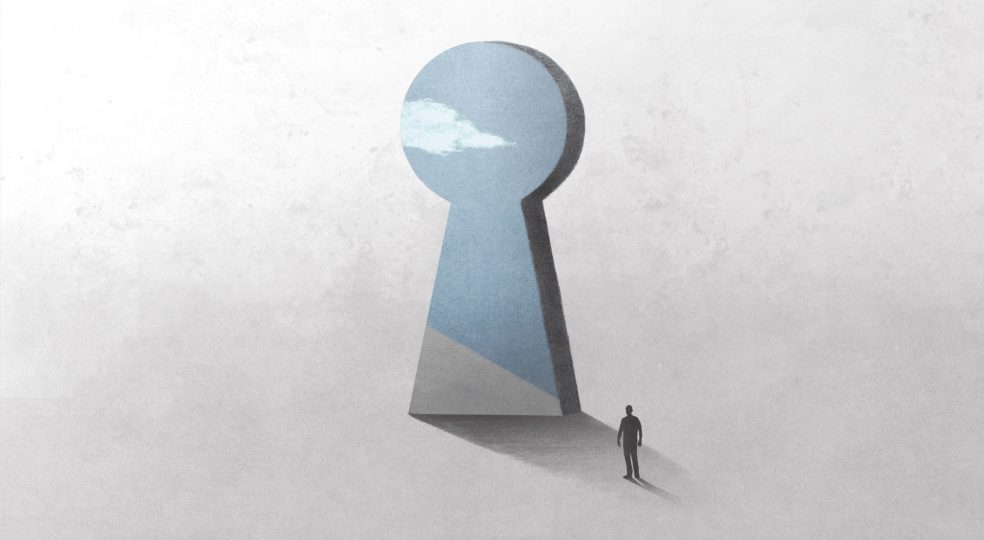
Our personality is shaped by several factors. In addition to disposition and upbringing, the personal experiences that happen to us in the course of life also play a decisive role. It is possible and desirable to develop one's own personality. Nevertheless, the motivations, fears and Hopes always follow a certain pattern.
The Enneagram divides nine different personality types. The latter is a profound and time-tested model, with the help of which the personality structure can be fathomed. The name Enneagram comes from the ancient Greek and means "nine-picture". With the knowledge of one's own personality type, the way is open to discover existing Potential and to rethink unloved behavior patterns.
The Enneagram Model is based on three energy centers, which are located in the head, the heart or the belly. Each of the Enneagram types preferentially uses one of the three energy sources.head people look at things rationally and make their decisions according to logically thought-out aspects. Safety and competence are important to them.
Heart people are very guided by their emotions and strive for recognition. They are often very empathetic and sensitive. Belly types are very concerned with their autonomy. They are driven by instinctive impulses. Belly types include types eight, nine, and one. Enneagram Types Two, Three, and Four can be classified as Heart Types. Types Five, Six and Seven are the head people.
Each of the three energy centers has one of the three central basic human needs as its theme: autonomy, recognition and security. In principle, every person feels all of these needs. However, the energy center provides information about which need dominates.

Below we would like to describe the 9 Enneagram types in more detail.
As the name already suggests, people feel from the Enneagram Type 1 the constant desire to improve things. Accordingly, they are very perfectionist. This often makes them workaholics. They often perceive their environment as chaotic and want to remedy the situation. Their eye for detail is enormously sharpened.
They are always painfully aware of their own shortcomings, as well as the problems of their fellow human beings. The effort to improve the environment can actually be very supportive. Those who are really stuck in chaos will readily appreciate the structured efforts of the Enneagram Type 1. However, people can be equally disturbed by attempts at reformation because they themselves see no reason to improve.
Despite all efforts, the goal of absolute perfection is unrealistic, which can frustrate type 1. For this reason, living together in a family or partnership is not always easy. However, those who appreciate the advantages of Enneagram type 1 have found a loyal and reliable friend or partner. You will look in vain for pleasure-seeking and frivolity. These are very serious and straightforward people.
They hold high principles and do not deviate from their values. The expectations they place on others they also fulfil themselves. People of Enneagram type 1 are in the best place in leadership positions. Their idealism can inspire others and drive them to high performance.
Type 1 fights relentlessly for his goals. However, this doggedness can lead him to forbid himself all the pleasures of life. It is also difficult for this personality type to show feelings, as he considers this a revelation of weakness.

People of the Enneagram Types 2 derive their self-esteem from helping others. They will go to any trouble to please someone else. They always put their own needs second. They consider giving love and support to be their purpose in life. They strive to keep their social fabric together in harmony.
People of Enneagram type 2 often appear calm and introverted. They are very emotional and devoted to their personal relationships. However, in return, they expect their self-sacrifice to be properly appreciated. Because Type 2 feels the need to help, they are often found in social and caring professions. Since these personality types not only desire but inwardly demand recognition for their willingness to help, such a career choice is obvious.
As a rule, Type 2 people are not quite as altruistic as they perceive their actions to be. In fact, they bring about a lot of good in their private and professional lives, but all of this is done against the backdrop of having their own Self-esteem to appreciate. People of Enneagram type 2 often make high demands on people close to them in terms of gratitude. This desire has an almost desperate character. If appreciation is not forthcoming, the type 2 becomes emotionally intrusive, which can disturb other people.
The unfulfilled Need for appreciation and recognition can drive the normally so kind and quiet type 2 to hysterical outbursts with irrational content. Type 2 is prone to burn-out or depressive moods because he neglects his own physical and mental needs.
People of the Enneagram Types 3 are focused on performance and personal success. They need the confirmation of their environment like the air they breathe. The idea of competition is always present, they want to be the best. Type 3 is willing to work hard for their goals. These may be professional or personal concerns, as it were. Type 3 works just as hard for a promotion as for a well-toned six-pack.
Type 3 is often early in life finds a professional and social field that harmonizes with his competencies. In this way, he receives the external recognition for which he strives. He appears charming and charismatic to those around him. People of Enneagram type 3 know how to present themselves perfectly. They radiate energy and Joie de vivrewith which they can carry away other people.
Maintaining professional and social contacts is extremely important to them, but this also has a selfish background. Type 3 knows how to exploit advantages. Contrary to appearances, they are plagued by a deep-rooted fear of failure. Allowing genuine closeness is difficult for this personality type, which interferes with deep friendships or romantic relationships. The fear that someone could see behind the façade is too great.
He lets himself be guided so much by external recognition that he no longer perceives his own needs properly. Sometimes type 3 leads a life that is envied by others, but does not fulfill him inwardly. He begins to lie to himself.

People of personality type 4 are convinced that they are very different from other people. They feel that they are unique. In a self-confident way, this makes them individualists. Nevertheless, they regard their perceived uniqueness not only as a gift, but also partly as a problem.
On the one hand, they pride themselves on standing out from the crowd. On the other hand, Type 4s often have the feeling that their individualism makes life difficult for them. The small happiness in everyday life often remains denied to him. Type 4 is in a conflict between a feeling of superiority and envy of other people who can take life easy. Type 4 is plagued by inner fears and doubts of having supposed shortcomings and faults that can be discovered by other people.
The emotional life of the Enneagram Types 4 can be described as extremely complex. Their greatest desire is to be accepted for who they are and to be appreciated for who they are. If the environment does not fulfill this need, the type 4 feels misunderstood and unwanted. Then they are only too happy to retreat into their own world.
Many Type 4 people feel the need to externalize their innermost feelings. They want to show the world their thoughts and Feelings participate. This impulse leads numerous people of this personality type into artistic professions. Quite a few well-known artists can be assigned to personality type 4.
Type 4 cultivates an idiosyncratic lifestyle. His self-realization and self-revelation play a central role throughout his life. If these personality types find themselves in trouble, they often wait for a savior instead of helping themselves.
Type 5 people are accompanied by a certain fear of life. They believe that they do not have enough strength to face the world and its challenges. To numb these fears, they flee into their own world. There they deal extensively with subjects they are passionate about. The retreat should continue to serve as a supposed preparation for the outside world.
At Type 5 people are usually extremely intelligent personalities who may have an artistic bent as well as an interest in the natural sciences or humanities. The world of learning and thinking is their home. Expressing emotions is difficult for them. They often try to keep other people at a distance. They do not want to emotionally overwhelmed will still be confronted with expectations that cannot be fulfilled.
Type 5 often lives a frugal lifestyle. In this way he demands little from others, who in return can demand little from him. Type 5 can sometimes be a little eccentric. Discussions with him can therefore be tedious, as he rarely allows himself to be swayed from entrenched convictions. He is a free thinker and does not want to be denied this right by anyone. Within relationships it can be problematic, because the type 5 is afraid of demands.
Most people of this personality type are shy and unobtrusive. They are reluctant to ask for help. So that their vulnerable side is not discovered, they not infrequently build themselves a wall of Indifference or even arrogance. However, if you succeed in bringing down this wall, the type 5 is a loyal friend and partner.

With the Enneagram Types 6 are insecure personalities who have difficulties with the rapid change of the environment. Impermanence makes them uncomfortable. In general, anxiety is a central theme for type 6. This can manifest itself, for example, in hours of brooding. Type 6 tends to fantasize about catastrophes and imagines what could happen in the worst case.
Their special circumspection makes these people reliable problem solvers, as they include every difficult aspect that would have remained hidden from other personality types. However, this robs them of Brooding enormous amount of life energy and joy. Those who worry constantly never find peace of mind. Therefore, many type 6 personalities suffer from inner tension. They can rarely engage in spontaneous activities because something unexpected might happen.
Type 6 has difficulty trusting other people. He remains cautious and skeptical until his counterpart has proven himself trustworthy. If the latter is the case, type 6 personalities are loyal companions. However, what sounds positive at first has negative aspects as well. His excessive loyalty tempts the type 6 to persist even in harmful life situations.
A distinction is made between two strategies that people with type 6 use to Fears combat: phobia or resistance. Phobic type 6 adopts avoidance behavior. In daily interactions, these individuals are friendly and cooperative. The resistant type 6 adopts a defensive attitude against any perceived threat. The result is downright daredevil behavior, but based on hidden fear.
People from the Enneagram Types 7 are always on the lookout for new challenges. Their thoughts focus on the future. What is past is past. This is their philosophy. Type 7 is therefore often restless and does not like to commit. He believes that a better opportunity could always be waiting for him.
Type 7 is literally bursting with energy. He loves to make plans. The environment often describes these personality types as open-minded and creative. People of this type are very concerned with the pleasures of life compared to the other 9 types of the Enneagram personality. However, the latter is a double-edged sword.
Not infrequently, their pursuit of sensual pleasures develops a kind of compulsiveness. This results from an avoidance behavior in order not to have to feel negative emotions. Therefore, type 7 not infrequently tends to addictions such as shopping addiction or alcohol addiction.
Type 7 usually has a positive self-image. He mentally focuses on his strengths and denies his deficits. This leads to a high degree of self-centeredness. He believes that his strengths and talents entitle him to make high demands on other people.
As already explained, type 7 is afraid of painful emotions. As a result, he also loses his sense for the sadness and pain of his fellow human beings. The degree to which Type 7 people try to numb their negative emotions is crucial to their mental health, so to speak. Being constantly on the run from pain and fear leads to depression and favors the development of Anxiety.

The Enneagram Type 8 attaches great importance to self-determination. Being controlled by other people or external circumstances is abhorrent to him. In order to maintain his autonomy, the type 8 has a high degree of willpower. He defends his goals and rights without compromise.
In order not to be controlled, most Enneagram Type 8 people acquire the ability to dominate others. If this tendency remains under control, they can be good bosses. It is not uncommon for the Type 8 to break out of an employment relationship or even completely out of social structures. He can only find peace in independence. Hierarchical structures in which he is not at the top, he can not stand and tolerate.
This Enneagram type is focused on living life to the fullest. While there is a powerful physical desire, few people of this Enneagram type can allow true intimacy. Intimacy for them is synonymous with emotional vulnerability, which fuels deep-seated fears. Those who betray type 8 must expect a violent backlash.
Gaining the trust of the Enneagram type 8 is not easy. However, when this person decides to reveal himself to someone, he is a loyal ally. People who are important to him, he defends ruthlessly. This is where his strong protective instinct comes into play.
In addition, he tends to choleric tendencies. After serious provocation may be outbursts of rage. If the type 8 suffers from mental illness, aggressive and violent tendencies may appear. Often this develops into a pleasure and satisfaction in suppressing supposedly weaker people.
People of this personality type feel a strong need for harmony. For this reason, they usually avoid conflicts. Now it is not possible to avoid conflicts. Daily life is characterized by solving major or minor conflicts. For this reason the Enneagram Type 9 not infrequently completely withdrawn from the outside world.
These Enneagram types seem closed to their environment. If they do participate in social activities, they often remain on the sidelines. In this way they want to avoid threats that could shake their inner peace. They are typical followers, which should spare them conflicts.
They are modest, friendly and tolerant personalities. They always want to see the best in others and are quick to trust. Deep down, they believe that fate will already turn out positively. If the Enneagram Type 9 has children, they care for them lovingly. Often these people also feel a strong connection to nature.
What they don't like at all, however, is change. After all, there could be potential for conflict lurking there. Type 9 is comfortable and extremely reluctant to take risks. They prefer to remain in a stable situation in life, even if this means missing opportunities. He rarely takes action to improve his circumstances. This is due to a lack of self-confidence.
Others often adopt the nines' underestimating self-image and give them little credit. This can cause underlying anger and also sadness. Although strongly withdrawn, the Enneagram Type 9 actually does not want to be overlooked.
Every person has a basic fixation on one Enneagram type that remains throughout life. However, it is not uncommon to observe personality traits of other Enneagram types. In this context, especially the so-called wings play a role.
These are the neighboring Enneagram types. People of type 6, for example, can have tendencies of type 5 and / or type 7. This is then abbreviated as "6w5" and "6w7". If no dominant wing prevails, one speaks of balanced wings.
The rarest Enneagram type or most frequent Enneagram type cannot be determined across the board. There are no studies on this. Basically, all Enneagram types are connected with each other, even if the lifelong basic fixation remains.

In addition to the Enneagram, there are other models for analyzing one's own personality. These include the Big Five model and the DISG model. The former does not classify the personality into types, but focuses on the characteristics of the five personality traits stability, extraversion, openness, adaptability and conscientiousness.
The DISC model has established itself as a leading model for not only exploring one's own personality, but also optimizing interpersonal communication. This is a decisive advantage over the Enneagram. In addition, the DISG model is more clearly designed and offers less room for misconceptions than the Enneagram.
DISG distinguishes four personality styles:
The dominant personality style loves challenges. These people are self-confident and like to make decisions. They want to see the results of their efforts as soon as possible. In addition, they are very freedom-loving.
The initiative personality style appreciates togetherness. He enjoys working in teams and sharing his productivity with others. He comes across as charming and open-minded to others. Initiative people can adapt well to new situations. New colleagues or acquaintances are integrated warmly.
Steady people like to act in the background. You are helpful and can therefore work well in Teams work. You appreciate Loyalty and longer-term (business) relationships. To others, these people often seem like calmness personified.
People with a conscientious personality style often develop a preference for data and facts. It is easy for them to find their way around predefined processes. Their actions and decisions reflect their forward-looking and systematic nature. People of this personality style are extremely inquisitive and have diplomatic skills.
Would you like to find out which Personality style you can be assigned? Then take our free personality test!

